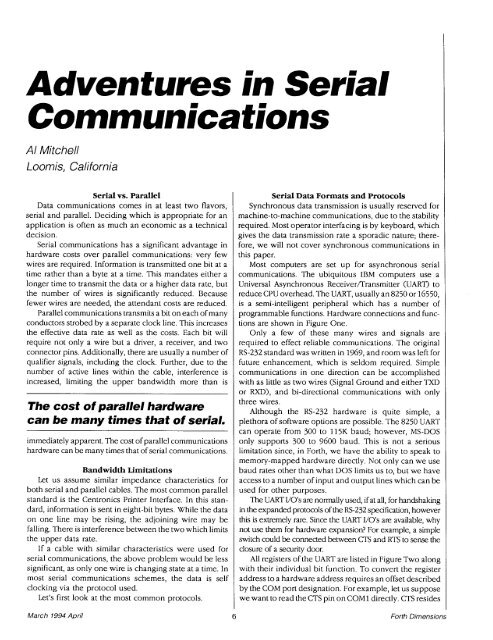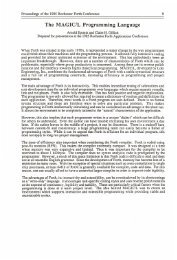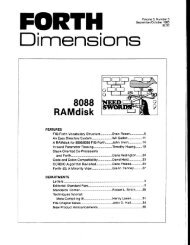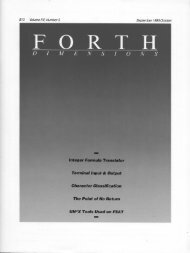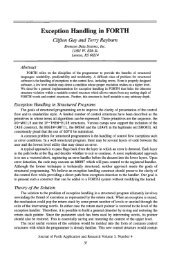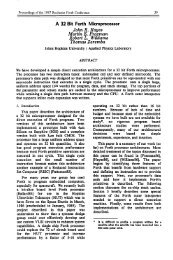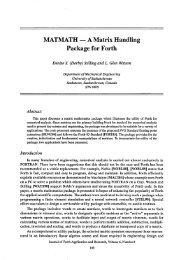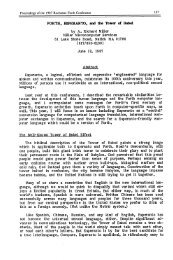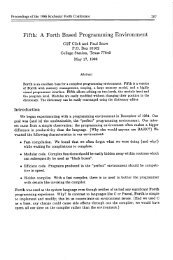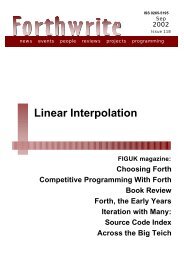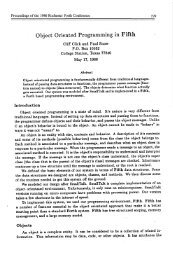FAST Forth Native-Language Embedded Computers
FAST Forth Native-Language Embedded Computers
FAST Forth Native-Language Embedded Computers
Create successful ePaper yourself
Turn your PDF publications into a flip-book with our unique Google optimized e-Paper software.
Adventures in Serial<br />
A1 Mitchell<br />
Loomis, California<br />
Serial vs. Parallel<br />
Data communications comes in at least two flavors,<br />
serial and parallel. Deciding which is appropriate for an<br />
application is often as much an economic as a technical<br />
decision.<br />
Serial communications has a significant advantage in<br />
hardware costs over parallel communications: very few<br />
wires are required. Information is transmitted one bit at a<br />
time rather than a byte at a time. This mandates either a<br />
longer time to transmit the data or a higher data rate, but<br />
the number of wires is significantly reduced. Because<br />
fewer wires are needed, the attendant costs are reduced.<br />
Parallel communications transmits a bit on each of many<br />
conductors strobed by a separate clock line. This increases<br />
the effective data rate as well as the costs. Each bit will<br />
require not only a wire but a driver, a receiver, and two<br />
connector pins. Additionally, there are usually a number of<br />
qualifier signals, including the clock. Further, due to the<br />
number of active lines within the cable, interference is<br />
increased, limiting the upper bandwidth more than is<br />
The cost of parallel hardware<br />
can be many times that of serial.<br />
immediately apparent. The cost of parallel communications<br />
hardware can be many times that of serial communications.<br />
Bandwidth Limitations<br />
Let us assume similar impedance characteristics for<br />
both serial and parallel cables. The most common parallel<br />
standard is the Centronics Printer Interface. In this standard,<br />
information is sent in eight-bit bytes. While the data<br />
on one line may be rising, the adjoining wire may be<br />
falling. There is interference between the two which limits<br />
the upper data rate.<br />
If a cable with similar characteristics were used for<br />
serial communications, the above problem would be less<br />
significant, as only one wire is changing state at a time. In<br />
most serial communications schemes, the data is self<br />
clocking via the protocol used.<br />
Let's first look at the most common protocols.<br />
Serial Data Formats and Protocols<br />
Synchronous data transmission is usually resewed for<br />
machine-to-machine communications, due to the stability<br />
required. Most operator interfacing is by keyboard, which<br />
gives the data transmission rate a sporadic nature; therefore,<br />
we will not cover synchronous communications in<br />
this paper.<br />
Most computers are set up for asynchronous serial<br />
communications. The ubiquitous IBM computers use a<br />
Universal Asynchronous Receiver/Transmitter (UART) to<br />
reduce CPU overhead. The UART, usually an 8250 or 16550,<br />
is a semi-intelligent peripheral which has a number of<br />
programmable functions. Hardware connections and functions<br />
are shown in Figure One.<br />
Only a few of these many wires and signals are<br />
required to effect reliable communications. The original<br />
RS-232 standard was written in 1767, and room was left for<br />
future enhancement, which is seldom required. Simple<br />
communications in one direction can be accomplished<br />
with as little as two wires (Signal Ground and either TXD<br />
or RXD), and bi-directional communications with only<br />
three wires.<br />
Although the RS-232 hardware is quite simple, a<br />
plethora of software options are possible. The 8250 UART<br />
can operate from 300 to 115K baud; however, MS-DOS<br />
only supports 300 to 7600 baud. This is not a serious<br />
limitation since, in <strong>Forth</strong>, we have the ability to speak to<br />
memory-mapped hardware directly. Not only can we use<br />
baud rates other than what DOS limits us to, but we have<br />
access to a number of input and output lines which can be<br />
used for other purposes.<br />
The UART VO's are normally used, if at all, for handshalung<br />
in the expanded protocols of the RS-232 specification, however<br />
this is extremely rare. Since the UART I/O's are available, why<br />
not use them for hardware expansion For example, a simple<br />
switch could be connected between CTS and RTS to sense the<br />
closure of a security door.<br />
All registers of the UART are listed in Figure Two along<br />
with their individual bit function. To convert the register<br />
address to a hardware address requires an offset described<br />
by the COM port designation. For example, let us suppose<br />
; we want to read the CTS pin on COM1 directly. CTS resides<br />
March 1994 April 6 <strong>Forth</strong> Dimensions


